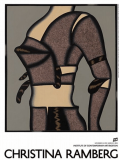
Christina Ramberg once wrote of watching, when she was a young girl, her mother dress for a party:
“She would wear these—I guess that they are called “Merry Widow[s]”—and I can remember being stunned by how it transformed her body, how it pushed up her breasts and slenderized down her waist. I think that the paintings have a lot to do with this, with watching and realizing that a lot of these undergarments totally transform a woman’s body. … I thought it was fascinating … in some ways, I thought it was awful.”
As a student at the School of the Art Institute of Chicago (SAIC) in the late 1960s, Ramberg demonstrated a preoccupation with 1950s gender constructions, her paintings depicting bodies forced into submission by undergarments designed to create an ideal female form.
In the 1970s, she moved toward androgynous, less sexualized figures and then to grotesque, non-human ones whose parts metamorphose into urns and chair backs, eliding the boundaries between figuration and abstraction, human and object. Throughout this evolution, a signature style remains: somber colors, meticulous surfaces, and figures filling a shallow field, cropped at neck and knee. Apparent are the artist’s keen eye for pattern and line and almost limitless influences, from early Renaissance painting to Surrealism to medical illustration.
Ramberg enjoyed modest success in her lifetime but has been largely overlooked since her untimely death in 1995 at age 49. Jenelle Porter, Mannion Family Senior Curator, has rediscovered the artist in this exhibition, which focuses on paintings made between 1971 and 1981, a period during which she created a radical, enigmatic, and accomplished body of work. In the later paintings, we see the mature artist returning to earlier themes with new innovation and formal clarity. Gone are the corseted ladies, cyborg armatures, and lace-clad volumes, and in their place are forms that assume the shape of a body, though not the flesh. Titles like Freeze and Melt show a fascination with transformation, as Ramberg recognized that materials and identities—whether liquid or the female body—are mutable.
